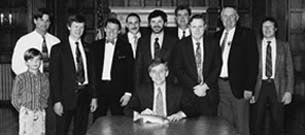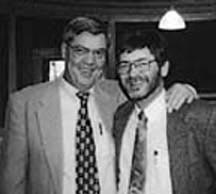|
|
|
| Subscriptions click here for 20% off! | E-Mail: info@rangemagazine.com |
|
|
||||||||||||
 |
Gathered for the bill signing ceremony for the Future Fisheries Improvement Act of 1995 are, left to right, Ric Smith, then president of Montana Trout Unlimited, and his son, Sen. Lorents Grosfield (R-Big Timber), George Ochenski, then lobbyist for Trout Unlimited, Legislative Council bill drafter Doug Sternberg, Rep. Bob Raney (D-Livingston), Republican Majority Leader Larry “Hal” Grinde, the late Rep. Dick Knox (R-Winifred), Senate Majority Whip Tom Beck (R-Deer Lodge), former Speaker of the House Rep. Hal Harper (D-Helena) and seated, Gov. Marc Racicot with the mascot for the fish bill. | |||||||||||
BUSTIN' OUTTA' THE RUTSMontana’s cowboys and enviros are working together.By George Ochenski |
||||||||||||
| Other than being Montana natives and state legislators since the
mid-’80s, Larry “Hal” Grinde and Bob Raney have little in common.
Grinde, the Republican Majority Leader, ranches a couple thousand
acres backed up to the Judith Mountains and can’t see his nearest
neighbor. Raney, a Democrat and former chair of the House Natural
Resources Committee, lives on a city lot in Livingston and can
almost touch the house next door. Grinde is a champion for private
property rights and business. Raney may be the legislature’s toughest
environmentalist. The last thing anyone would expect is for these two guys to work together. Yet, for most of the last decade they have done just that and managed to pass some of the most innovative natural resource legislation in the nation. Raney says splitting conservationists and cattlemen has been “one of the biggest mistakes we ever made in the West. While we’re busy fighting each other, the developers are having a field day chopping up ranches, sticking trophy homes on the ridgelines and filling the valleys with subdivisions.” The two men began their unique and successful working relationship in 1993, by co-sponsoring legislation to keep Montana’s state parks in a natural and undeveloped condition. Then, prior to the ’95 legislature, Raney approached Grinde with an idea for a stream restoration program that puts public money into on-the-land improvements to create natural spawning habitat for trout. “When Bob approached me, I was skeptical,” admits Grinde. “But my God, what a concept: clean up an area where fish can live, give ’em a place to mate, and we have new fish. And the government doesn’t control it. Very basic, very sound.” “Fact is,” says Raney, “most of the small spawning streams are on private land. We knew the program wouldn’t have a chance if ranchers and farmers didn’t buy into it.” The two found significant support among fellow legislators as Grinde worked the ranchers and Raney worked the enviros. Grinde says most ranchers don’t have a problem with fixing up streams to benefit the fish, “The problem is finding the money to pay for it.” After analyzing agency budgets, they found millions of dollars being spent on hatcheries while almost nothing was spent on stream restoration. “We decided to redirect some of that hatchery money into fixing up streams,” says Raney. “Our goal was to get the work done cost effectively without going through a lot of bureaucracy.” What surprised them was the vicious opposition from the Montana Department of Fish, Wildlife and Parks. The agency didn’t want its hatchery budget changed, nor did it want public money spent on private land unless there was guaranteed public access. As a testament to the power of cowboys and enviros working together, the bill passed the legislature with a $2.5 million appropriation attached. In the ensuing years, the program proved popular with landowners while successfully restoring streams. When Secretary of the Interior Babbitt visited Montana in ’98, he praised the results. “In six years of traveling to every corner of the West, I haven’t seen anything as powerful as the message here–how you’ve come together, talk together, work together. I will tell people wherever I go that if they want to see a model of what’s possible, they ought to come up here and look and listen and learn.” Ironically, the state fish and wildlife agency now holds up the stream restorations as one of its great accomplishments. “What we learned,” says Raney, “is that government often benefits by keeping conservationists and cattlemen on opposing sides. Then they can mediate solutions–which usually results in bigger bureaucracies, more studies and less on-the-land work.” Building on the success of their joint efforts, Grinde and Raney introduced “The Good Neighbor Policy” in the 1999 legislature to reduce impacts from public recreational sites on adjoining landowners. The bill requires the state’s fish and wildlife agency to make maintenance a priority over development at the state’s 43 parks and 312 fishing access sites. “Maintenance” means weed control, fencing, cleaning latrines, picking up litter, stabilizing streambanks, and protecting riparian areas. “Landowners were having negative reactions to the condition of these areas,” says Raney. “From blowing litter to noxious weed invasions, fewer folks were willing to have public recreational sites as neighbors. Better maintenance goes a long way to address those concerns.” Both legislators again worked their groups and once again they were successful. The popular polemic is that these two should be at each other’s throats–if not because of their political parties, then because of their constituencies. Instead, the bond created by working together has grown over the years. “We basically trust and respect each other,” says Raney, “which goes a long way toward getting things done.” Through the interaction, Raney has come to appreciate the difficulties of modern ranching and the value that large, intact ranches bring to the state. “When you mention Montana, people think of vast open spaces, towering mountains, and ranches,” says Raney who points to growth pressures that are changing the state. “The ranches anchor us to the lifestyles and landscapes that define Montana. I’m committed to do whatever I can to keep those values and ranches intact.” As for the impacts ranching can cause on the land, Raney says, “We can take care of ranching problems using modern management methods. But just try getting rid of even one subdivision or trophy home–that’s impossible.” For his part, Grinde thinks the “partnership” has worked well, too. “I think if more environmentalists thought it through, they would come to the same conclusions. In the long run, ranching has far less impact on the land than development.” Grinde says some people thought he’d get burned by working with an environmentalist. “But that just hasn’t happened. The laws we’re passing are making Montana better for ranchers and better for the environment. Nobody’s selling out–we’re just using our heads for something besides hat racks and bustin’ out of some old ruts.” Both men point to the lack of cooperation from government agencies as one of the biggest problems they have faced. “Don’t be fooled by all this mumbo-jumbo about |
||||||||||||
 |
||||||||||||
“Don’t be fooled by all this mumbo-jumbo about government serving the people,” says Raney. “Government serves itself first. It is up to public policy makers–state and national legislators–to get government agencies to do what’s right for today.” |
||||||||||||
| Montana's unlikely resource allies Hal Grinde and Bob Raney. |
||||||||||||
|
government serving the people,” says Raney. “Government serves
itself first. It is up to public policy makers–state and national
legislators–to get government agencies to do what’s right for
today.” Both men say large bureaucracies don’t like to change
and warned that government agencies will use public resources
and money to lobby against bills the agencies don’t like. George Ochenski writes from Helena, Mont., where he has successfully lobbied the Montana Legislature on environmental, natural resource and tribal issues since 1984. He keeps in touch with the natural world by climbing, skiing, fishing and camping in his beloved “Big Sky” state. |
||||||||||||
|
To Subscribe: Please click here for subscription or call 1-800-RANGE-4-U for a special web price Copyright © 1998-2005 RANGE magazine last page update: 04.03.05 |
||||||||||||
